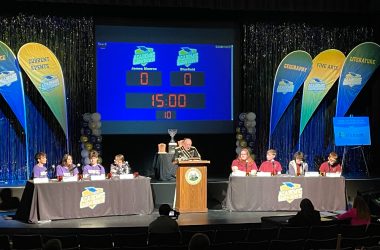By COURTNEY HESSLER
The Herald-Dispatch
HUNTINGTON, W.Va. — An Ohio drug dealer collapsed into his chair in tears at the federal courthouse in Huntington on Monday as he was sentenced to serve more than 18 years in federal prison for distributing pink heroin in Huntington, which resulted in 26 overdoses on Aug. 15, 2016.

(Photo by Courtney Hessler)
While his demeanor at sentencing was somber, Bruce Lamar “Benz” Griggs, 22, of Akron, Ohio, only offered a single four-letter word for his victims and Huntington when exiting the courthouse.
Griggs was sentenced to 18 years and four months in prison and three years of supervision after his release by Chief U.S. District Judge Robert C. Chambers, who said Griggs took advantage of addicts in Huntington. He previously had pleaded guilty to the distribution of a quantity of heroin.
“I would like to apologize for all the pain I caused. I am truly sorry,” he said. “I never wanted to cause any harm.”
Chambers spoke directly to Griggs for nearly 10 minutes before sentencing.
“Heroin is like driving intoxicated,” he said. “You may not mean harm to anybody, but you have to serve a sentence commensurate with the harm you did.
“You’re lucky no one died, but that’s largely thanks to (first responders) that saved their lives,” he said.
Chambers said although two people died of overdoses within hours of Griggs’ distribution, they had not been tied to the dealer.
According to documents filed by Carl Hostler, who represents Griggs, the drug dealer made five trips to Huntington between July and Aug. 15, 2016, with the intention of selling heroin. Each time he would usually buy $1,000 worth of heroin and sell it for $20 to $60 at a time.
Griggs had been out of jail on a previous conviction for about two months before he started traveling to Huntington.
In 2014 he pleaded guilty to possession of a controlled substance and was given 18 months of probation in return. He was imprisoned for a year in 2015 after violating probation terms and by May 13, 2016, he was released.
On his final trip, Griggs is seen on video from cameras maintained in the Marcum Terrace area from 2:09 to 3 p.m. dealing the drug, which later was found to be mixed with fentanyl, an opioid used as part of anesthesia to prevent post-surgery pain, and carfentanil, an elephant sedative 100 times more potent than fentanyl.
He knew the color of the heroin was the color of peach, different from a normal white or light brown color, but still distributed it, his attorney wrote.
By 3:30 p.m. that day, calls were pouring into Cabell County 911 from people witnessing overdoses. Within a six-hour time frame 26 overdose calls had been reported. Worried callers told dispatchers people were coming to a home and dying.
Chambers indicated a woman who was with Griggs on Aug. 15, 2016, overhead a phone call from whonever he had purchased the heroin from informing him of the tainted drug. Chambers said Griggs even blamed addicts for using too much of the drugs and causing the overdoses.
“(The) most disturbing (thing) is hearing of heroin causing people to (overdose), and you continued to distribute,” he said.
U.S. attorney R. Gregory McVey said Griggs knew exactly what he was doing in introducing Huntington to the new drug from his hometown.
“Akron has a fentanyl and carfentanil epidemic, more so than anyone,” he said. “This was the first major influx of these drugs (in Huntington).”
Twelve doses of naloxone, the opioid overdose-reversing drug, were used to revive victims. Three of those were for one patient. The remaining patients were revived using bag-valve masks, handheld devices used to provide ventilation to patients not breathing.
Days later, law enforcement agencies tied two deaths to heroin overdoses. One man died at Cabell Huntington Hospital after friends did not disclose his drug abuse history, including previous overdoses. A second man was found dead of an overdose at Prestera Center’s Pinecrest apartments on U.S. 60.
On Monday, Chambers said no deaths were connected to Griggs.
An outbreak report released by the Centers for Disease Control and Prevention and the Department of Health and Human Resources in January surmises the number of overdoses could have been as many as 48 people.
Griggs accepted responsibility for “multiple” overdoses rather a substantive number.
McVey referred to the drug as “fentanyl laced with heroin” rather than heroin mixed with fentanyl.
“He was here specifically to make money,” he said. “And no other reason.”
In letters addressed to Chambers, family members described Griggs as a father figure to his younger siblings who fell into the wrong crowd after being expelled from high school and losing a Division I football scholarship. He was trying to bring additional money into a single-parent household to help his mother, Hostler wrote.
Chambers said Griggs was a disappointment to a caring family.
“You came from a good family. (Your brother) looked up to you,” he said. “I’m sure it’s a huge disappointment to your mother.”
Griggs was granted a transfer to Elkton federal prison to be closer to his family and permission to enter a drug rehabilitation program for what he said was a marijuana and Benzodiazepine addiction.
Any person looking for help with substance abuse and addiction can contact the state hotline 24 hours a day at 844-435-7498 or visit www.help4wv.com.
See more from The Herald-Dispatch





